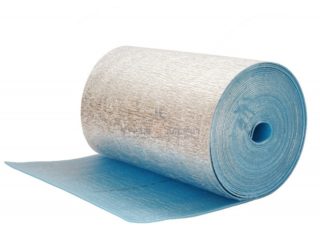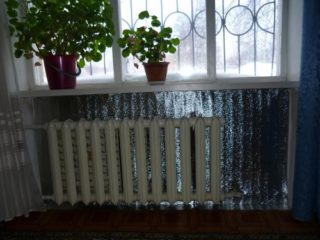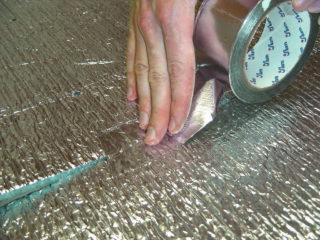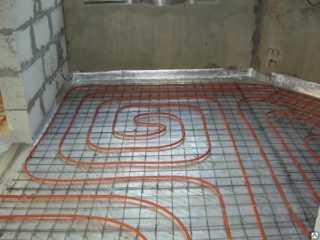One of the best modern thermal insulation materials (TIM) is Penofol roll insulation. It is widely used for warming loggias, walls, roofs, during construction and repair work. It is used for insulation of pipes of the heating and water supply systems. Penofol is a representative of a new class of TIM, whose action is based on the reflection of thermal radiation. This class of insulation is called reflective thermal insulation (OTI).
Features of Penofol
The material is gas-filled polyethylene. Ethylene-based polymer is chemically inert, environmentally friendly, has a wide range of insulating properties (heat, sound, hydro and electrical insulation) and low weight.
Penofol consists of several parts:
- foam base
- foil (foiled basalt wool) on one or both sides of the polymer.
The thickness of the foil is 20 microns, and the thickness and density of the polymer layer may be different. Most often, foamed insulation Penofol with a thickness of 2 to 10 mm is used, in special projects they are used with a thickness of up to 40 mm.
Specifications
Penofol can be used in the temperature range of -60 / + 95 ° C. The rate of thermal reflection from the surface is more than 97%.
For comparison, in order to get the same thermal insulation indicator, you need:
- the expanded polystyrene layer is 1.8 times thicker;
- the mineral wool layer is 2.2 times larger.
The thicker the insulation layer, the more space it requires, reducing the volume of the room.
Advantages and disadvantages
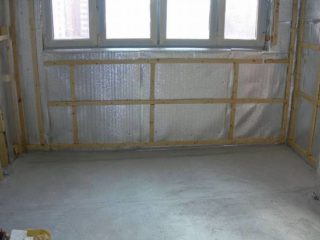
Being one of the latest technological solutions to the issue of thermal insulation, foil foamed polyethylene has both strong and weak qualities.
Advantages of the material:
- insignificant thickness with high thermal insulation;
- ease of use - does not require special equipment, easy to cut with ordinary scissors;
- the material is soft, does not crumble or break when used;
- environmentally friendly;
- good hydro and noise isolator;
- fireproof;
- rolls are easily transported;
- affordable.
For comparison: the popular mineral wool insulation is inferior to Penofol by almost 2 times in thermal insulation properties, with low moisture resistance it has a restriction on use in wet rooms. Therefore, choosing between foamed polyethylene and mineral wool, preference is given to the first.
The weakness of Penofol is softness - with slight pressure, it bends, which does not allow the use of material for plaster or wallpaper.
Scope of application
Penofol can be used as the main or additional reflective thermal insulation. As the main material, it is used to insulate walls from the inside, and in wooden houses for a warm floor.
As an additional thermal insulation, the material is used in the arrangement of residential and industrial premises.
Using Penofol allows you to simultaneously solve several issues:
- reflected heat;
- waterproofing;
- vapor barrier.
The material can be used not only for internal work - the insulation is also effective for warming the walls of the house from the outside.
Types of Penofol
The material is available in several versions. The main types and scope of use.
- Type A. The foamed polymer is coated with a foil film on one side only. During installation, the aluminum side should look inside the room.
- Type B. The polymer is coated with a reflective film on both sides. Such an insulator will effectively reflect excessive temperature in hot weather and will preserve the internal heat of the room in the cold.
- Type C. Modification similar to Type A: the polymer is coated with foil on one side only. The other side is a self-adhesive surface. Such an OTTI is used in places inconvenient for installation, since it does not require any fasteners.
Lightweight and environmentally friendly heat insulator will help insulate the whole house. Penofol is used to warm the floor, roof and walls on both sides. It is easily mounted in the space behind the heating radiator. Ideal for warming a loggia or balcony.
When using OTI, an air layer of at least 2 cm should be between the insulation and other elements.
Warming of walls and floors of rooms, balconies and loggias
Modern insulating materials allow, even with a little experience, to make the insulation of a room or balcony with your own hands. It is used as an additional - the main insulation of the room or balcony is performed by foam.
Before attaching Penofol, all cracks or gaps must be filled with mounting foam.
Similarly, jointly using penoplex and Penofol, warming the loggia is performed.
Scheme of warming a room or balcony:
- Level and primer the surface.
- Attach the foam insulation panels.
- Attach the Penofol strips with the reflecting side to the room.
Penofol strips are tightly joined together, and sealed with aluminum tape.
For the final decoration of the walls you will need a frame for drywall or plastic panels. When insulating the floor, a reinforcing layer is made and poured with a screed.
Under floor heating
Underfloor heating, water or electric, requires mandatory thermal insulation. The most popular material is Penofol. It is laid directly on the overlap with the foil side up. The thickness of Penofol for underfloor heating is chosen so as not to raise the surface too much.
When using cement mortars for floor finishing materials, the Penofol aluminum coating is partially destroyed - this is taken into account by the manufacturers of the material, so the reflective layer is applied with a significant excess.
Penofol insulation in a wooden house
Inside a wooden house, it is effective to use foamed insulation Penofol for walls in all rooms. When mounting on walls or a ceiling, it is placed between two layers of a battens crate, at a distance of 2 cm from each. You can fix it with a furniture stapler or small studs. The insulation is fixed on the lath joint to joint. The joint line is additionally insulated with aluminum tape.
The internal lathing is used for fastening panels or sheet materials that will be painted or wallpapered.
Penofol is not used to warm the facade of wooden houses - the material "does not breathe", due to accumulated moisture, the tree will collapse.
The use of expanded polyethylene in wooden houses and outbuildings has another plus - because of the small thickness, rodents do not settle in it. When using foam or mineral wool, there is such a problem.
Foiled foamed polyethylene is successfully used for warming any premises, has a high thermal insulation rate and does not require additional equipment.Among modern materials, Penofol is one of the best representatives of reflective thermal insulation.
